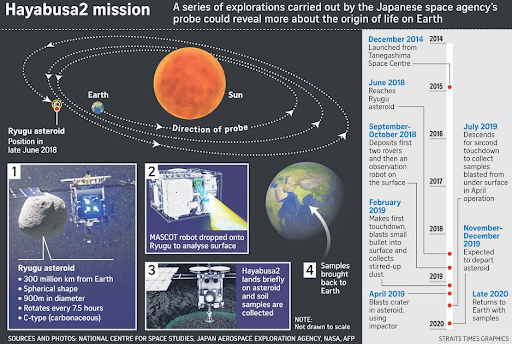Why in the News?
Recently, scientists made the hypothesis after analysing samples from the asteroid Ryugu, collected by the Hayabusa-2 probe.
Key Points:
About Hayabusa-2 Mission
- The Hayabusa-2 mission was launched in 2014 to study the asteroid Ryugu.
- Launching Agency: Japan Aerospace Exploration Agency (JAXA)
- Purpose: It seeks to answer some fundamental questions like:
- the origins of the solar system and water molecules.
- Hayabusa-2 delivered a small capsule that contained the rock and dust samples when it was 220,000 km from the Earth’s atmosphere.

Image Source: National Centre for Space Studies
What is an Asteroid?
- Asteroids are rocky objects that orbit the Sun, much smaller than planets. They are also called minor planets.
- Asteroids are divided into three classes:
- First, those found in the main asteroid belt between Mars and Jupiter, which is estimated to contain somewhere between 1.1-1.9 million asteroids.
- The second group is that of trojans, which are asteroids that share an orbit with a larger planet.
- The third classification is Near-Earth Asteroids (NEA), which have orbits that pass close by the Earth.
Why do scientists study asteroids?
- Scientists study asteroids to look for information about the formation and history of planets and the sun.
- Another reason for studying asteroids is to look for asteroids that could possibly crash into Earth, leading to potentially hazardous consequences.
News Source: The Indian Express
 Profile
Profile Settings
Settings Refer your friends
Refer your friends Sign out
Sign out





